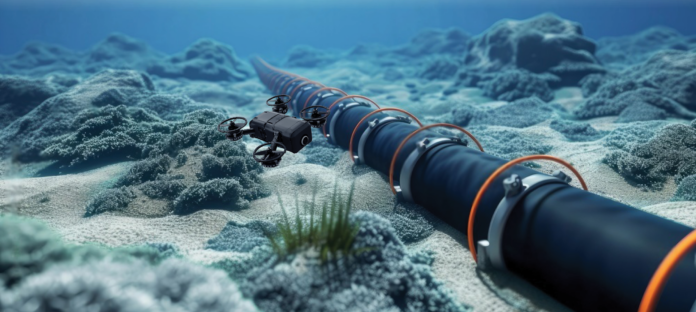Across various industries such as offshore oil and gas, renewable energy, aquaculture and infrastructure inspection, subsea drones are crucial. Traditionally, these inspections have relied on divers or Remotely Operated Vehicles (ROVs), both of which come with significant cost implications.

“Deploying a diver or vehicle beyond 50 meters can cost around USD $13,000, while operations at greater depths often exceed USD $65,000,” says Dr. Alec McGregor – Senior AI engineer at Advanced Navigation.
However, the emergence of subsea drones, also known as Autonomous Underwater Vehicles (AUVs), is revolutionizing the industry, offering a potentially more cost-effective solution.
The Cost-Effectiveness of Subsea Drones
Subsea drones offer a significant departure from the traditional methods, providing a cost-effective solution with improved efficiency. As McGregor states, “Subsea drones, also known as micro-AUVs, represent a paradigm shift in the subsea technology market that was once prevalent with large remotely operated vehicles (ROVs). This is driven by the market’s increasing need for regularly updated data, and consequently, equipment that can enable faster, more frequent and logistically simpler surveys.”
Their reduced operational costs stem from several factors, which includes:
Lower upfront investment: Compared to ROVs, subsea drones are significantly more affordable to purchase. A range of drone models are available, catering to different budgets and inspection needs.
Reduced operational costs: Subsea drones require less support infrastructure than ROVs. While some deployments may still benefit from a support vessel, many inspections can be conducted autonomously or with minimal support, reducing crew costs, fuel consumption, and mobilization expenses.
“The underwater market is trending towards the use of miniaturized subsea drones that can effectively act as an all-in-one autonomous surveying crew while reducing costs significantly,” remarks McGregor.
Increased efficiency: Subsea drones can operate for longer durations and cover larger areas than divers, streamlining the inspection process. Their autonomous capabilities allow for programmed inspection routes, ensuring comprehensive coverage and minimizing human error. This translates to faster inspection time and reduced overall project duration, leading to significant cost savings.
Improved safety: The elimination or reduction of human exposure to hazardous underwater environments significantly minimizes the risks of accidents and injuries, thereby reducing insurance premiums and potential liability costs.
Enhanced data acquisition: Subsea drones can be equipped with a variety of sensors and cameras, which enables the collection of high-resolution images, video footage, and other crucial data. This enhanced data acquisition improves the accuracy of inspections and reduces the need for follow-up investigations, saving both time and money.
Cost Savings Examples
The cost savings associated with subsea drones can vary depending on the specific application, here are a few examples that illustrate their potential benefits:
Offshore wind farm inspections: Subsea drones can effectively inspect the foundations, cables, and other underwater components of offshore wind turbines, significantly reducing the cost and time compared to traditional methods. The elimination of diver deployments and the reduced reliance on expensive ROVs results in substantial savings.
According to McGregor “Existing equipment that helps overcome the risks with marine exploration is often task-specific, requiring the use of ROVs—weighing anywhere between 220 and 2200 lbs depending on their class—and highly trained crews with specialized skills. Operating at depth presents significant engineering challenges, from withstanding immense pressure to ensuring reliable communication, power, and maneuverability in extreme environments. These complexities drive up costs considerably.”
Pipeline inspections: Subsea drones can autonomously navigate pipelines, capturing high-resolution imagery to detect corrosion, leaks, or other structural defects. Their ability to access confined spaces and operate in challenging conditions makes them a particularly cost-effective solution for pipeline integrity management.
Aquaculture inspections: Subsea drones can monitor the health of fish farms, inspect net cages, and assess environmental conditions. Their maneuverability and ability to capture detailed imagery allow for early detection of problems, preventing costly losses.
Reef Conservation: “Take reef conservation for example,” says McGregor. “monitoring long-term trends in coral reef status requires repeating surveys of an area regularly. Coral reef health is becoming increasingly important as governments and institutions look to protect these habitats. As monitoring reefs and ocean conditions becomes more frequent, traditional methods involving bulky equipment and a diving crew show shortcomings in keeping the data lifecycle up to date. In this case, data quickly becomes obsolete.”
Bridge and Dam Inspections: Inspecting underwater bridge supports and dam structures is crucial for ensuring public safety. Subsea drones can provide detailed visual inspections and sonar surveys, identifying potential cracks, erosion, or other structural defects.
A Promising Alternative
While the cost of subsea drones varies depending on the specific model and the complexity of the inspection, they represent a significantly more cost-effective alternative to traditional methods for many underwater inspection applications.
As McGregor concludes, he highlights that, “The cost-effectiveness of utilizing subsea drones runs long-term. For instance, the resources and capital spent on training a dive crew can be reallocated to the management, stewardship and communication of high-fidelity data. From there, industries will be able to make truly informed and data-driven decisions for their business.”
Additionally, as technology continues to advance and the cost of subsea drones decreases, their adoption will likely accelerate across various industries reliant on underwater inspections. The adoption of subsea drones is poised to revolutionize underwater inspections, providing a safer, more efficient and more affordable way to explore and manage the underwater inspections.



